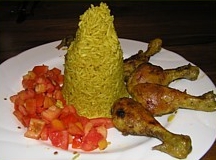| |
- 500 GRAM SQUID, cleaned
- 1 ONION, chopped
- 1 CLOVE GARLIC, chopped
- 50 GRAM NOODLES, soaked
- 50 GRAM DRIED MUSHROOMS, soaked
and cut
- 1 TSP FIVE SPICES POWDER
- 1 TBSP SOY SAUCE
- 400 GRAM MINCED PORK
|
- 300 GRAM RICE
- 1 1/2 CUP COCONUT MILK
- 1 CUP CHICKEN STOCK
- 1 SALAM LEAF
- PIECE OF TURMERIC ROOT, sliced or 1 TSP TURMERIC POWDER
- PIECE OF LEMON GRASS, bruised
- PIECE OF GALANGAL ROOT, sliced
|
Stir fry the onion and the garlic for
three minutes. Mix the pork mince with the onions and the garlic, five
spice powder, mushrooms, noodles and soy sauce and stuff the squid with
this mixture. Fry the squid 10 minutes on each side and slice them.
|
Put all ingredients
together and bring to the boil. Cook 10 minutes on medium heat and 10
minutes on very low heat. Take out the salam leaf, the lemon grass and
galangal. Shape the rice into a cone or mountain. Serve with cucumber
and tomato, ayam panggang
and sambal oelek
trassie.
Nasi kuning is served
at Hindu festivals and popular on
Java and
Bali.
It is originally Indonesian. The conical shape represents the sacred
Hindu mountain Meru, and yellow is one of the four important Hindu colors
and means sun or royalty. Kuning means yellow. In the Netherlands, I
have seen Nasi kuning served for Easter. It is served in almost the
same way in the Nonya kitchen, here sometimes garlic and onion are added
and the rice is decorated with chilies.
On the 4th of
March 1621, the
Dutch, who had conquered
the island of Java, named it "Batavia". Click on
culinary calendar for more links
between cooking and celebration.
|
